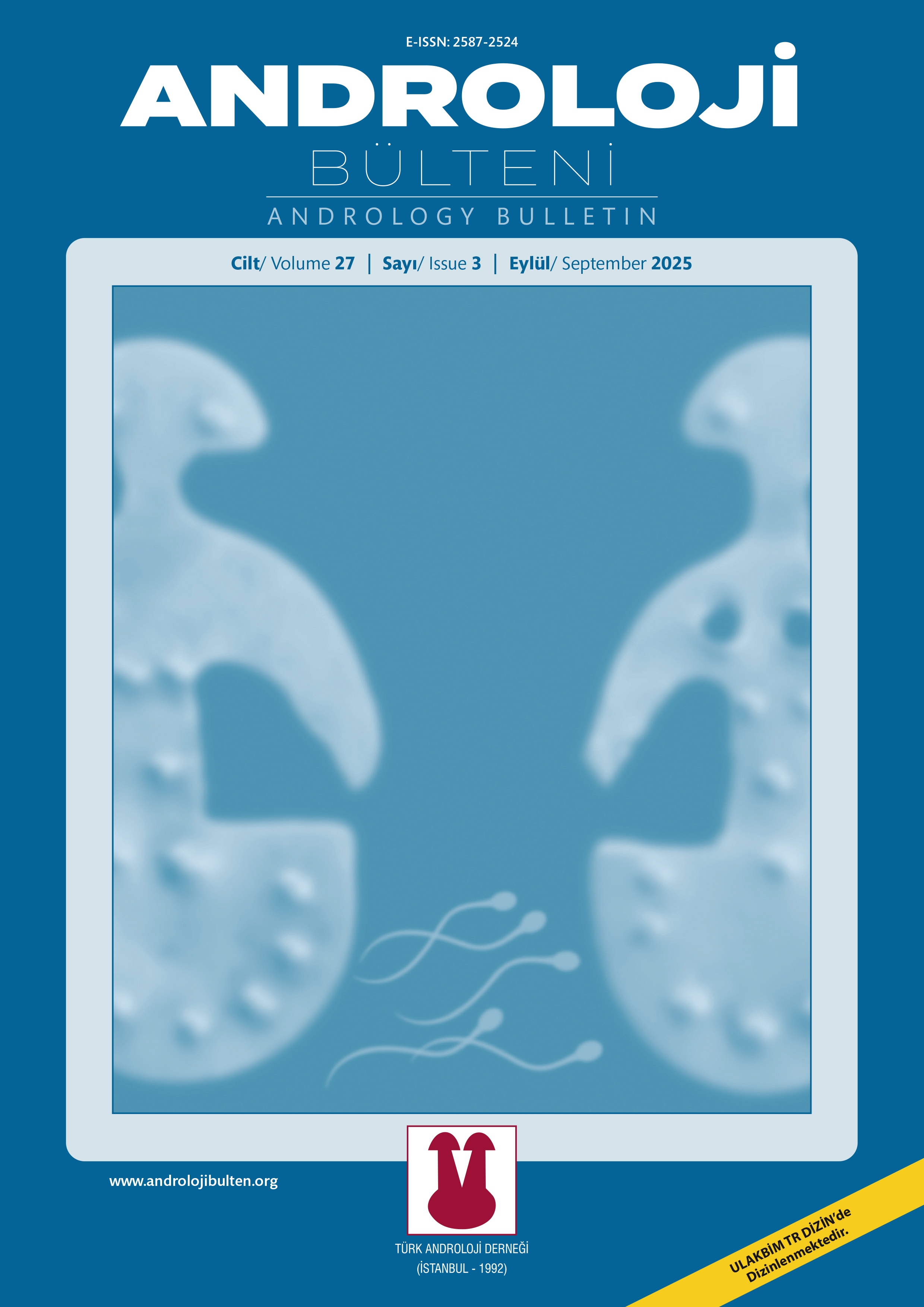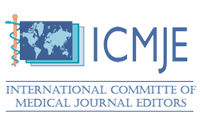
Content of this journal is licensed under a Creative Commons Attribution-NonCommercial 4.0 International License.
Instruction to Authors
Articles submitted to the journal are evaluated in terms of originality and scientific quality. Submitted manuscripts must not have been previously published, or presented in another electronic or printed journal, in a book or in a different medium, and must be approved by the Editorial Board of the Turkish Andrology Association's Board of Directors.
Independent, unbiased, double-blinded arbitration evaluation reports of referees are used in the evaluation of the articles submitted to the Andrology Bulletin. In order for the articles to be evaluated, a signed letter entitled "Copyright Transfer Form" must be attached to the submitted article, confirming the authors' approval (a copy of the form is available at: http://www.androlojibulten.org and https://jag.journalagent.com/androloji/).
By signing this form, the authors agree that if the article is accepted for publication by Andrology Bulletin; They agree to obtain a Creative Commons Attribution-Non Commercial 4. 0 (CC BY-NC 4. 0) International License so that the material may be adapted and shared by third parties for non-commercial purposes only, with appropriate credit given to the original work. For more details on the CC BY-NC 4. 0 license, please see https://creativecommons.org/licenses/by-nc/4.0/.
Andrology Bulletin encourage authors and individuals involved in the evaluation process of submitted articles to present their current or potential conflicts of interest, including financial, institutional, and other relationships that may lead to potential conflicts of interest or prejudice. Any financial or any other kind of support received from an individual or institution for a study must be declared to the Editorial Board, and the ICMJE Potential Conflicts of Interest Form must be filled in separately by all authors contributing to the declaration of potential conflicts of interest (see the form in: http://www.androlojibulten.org). Potential conflicts of interest with editors, writers and arbitrators are resolved by the Editorial Board of the journal under the COPE and ICMJE guidelines.
The Author Approval Form will be sent to the responsible author, who will be required to explain the author's contributions during the typesetting and preparation of the articles suitable for publication.
Only those who deserve authorship should be shown as authors. Everyone listed as a writer must meet the authorship criteria recommended by ICMJE (http://www.icmje.org/). The ICMJE suggests that authors meet the following four criteria:
- To have contributed significantly to the gathering, analysis, and interpretation of data for concept/design of the study;
- To have drafted the writing of the essay, or have done critical review of important intellectual content;
- To have reviewed and approved the last version of the article before its publication;
- To accept the responsibility for all aspects of the work in order to ensure that questions concerning the validity and accuracy of any part of the work are properly investigated and resolved.
A writer should be able to identify the parts of the work which other authors are responsible for, in addition to taking responsibility for the parts he contributed. In addition, authors should trust the integrity of each other's contributions.
For the clinical and experimental studies, drug studies, and some case reports, the Ethics Committee report prepared under the World Medical Association Declaration of Helsinki (amended in October 2013, https://www.wma.net/) is required. If necessary, the author(s) may be requested an Ethics Committee report, or an official letter of equal value. An explanatory note on the results of experimental studies on humans should be included in the text to the effect that approvals have been received, once the nature of the procedures applied to the subject has been fully explained. In the case of studies on animals, those made for the avoidance of pain, suffering, and discomfort should be clearly stated in the article. Patient approvals, the name of the institution from which the Ethics Committee report is received, and the number and date of the approval document should be stated in the main text file under the title of Methods. It is the responsibility of the authors to protect the confidentiality of the identities of patients. Signed permits from the patient or legal representatives must also be sent for photographs that may reveal the identity of the patients.
Similarity checking of all the articles is done via iThenticate software.
The Editorial Board will act in accordance with the COPE rules against claims and suspicions of plagiarism, citation manipulation, and data fraud involving work submitted to the journal. All responsibility for the published content belongs to the authors.
Submitting articles onlineAll manuscripts must be submitted online via the internet address of the journal (https://jag.journalagent.com/androloji/). It is recommended that the manuscript be reviewed one last time with the checklist before submission. Manuscripts not written in accordance with the writing rules are not accepted for Scientific Board evaluation. More information can be found at https://jag.journalagent.com/androloji/.
Preparation of ArticlesThe research articles should not exceed 3000 words, the case presentations should be at most 1500 words, and the compilations should not exceed 5000 words.
The articles should be prepared in accordance with the ICMJE - Recommendations for the Conduct, Reporting, and Publication of the Scholarly Work in Medical Journals (http://www.icmje.org/icmje-recommendations.pdf –updated in December 2017). Randomized studies should be consistent with CONSORT, observational studies with STROBE, diagnostic value studies with STARD, systematic review and meta-analyses with PRISMA, animal trials with ARRIVE, and non-randomized behavioral and public health studies with TREND guidelines.
The authors are required to upload the Publication Submission Form, the Author Contribution Form and the ICMJE Potential Conflicts Form (this form must be filled out by all authors separately) to the online system during the initial submission of the article. These forms are available at http://www.androlojibulten.org/ and can be found in the instruction to authors section.
Manuscripts should be typed on a standard A4 paper size on a computer text file, spaced about 2.5 cm on the right and left sides, and with double spaced lines. Every page should be numbered. The text should be written in Times New Roman font with 12 points. The sections to be included in the manuscripts are: author names (academic title, name, surname), the institution in which the study was conducted (work place of the author and the institution where the publication is prepared), contact address, telephone and fax numbers, e-mail address. All these should be entered in the JournalAgentTM program online in steps 3, 4, and 5.
The files to be uploaded should not contain the names of the authors and places where they work, except the "Copyright Transfer Form". The submitted work should include:
- Turkish and English titles (to be posted online),
- Turkish and English abstracts (to be posted online); in the full text of the article (the full text file must be added to the desired location online)
- Introduction;
- Materials and Methods;
- Findings;
- Discussion;
- References sections.
It is preferred that methods, findings, and discussion sections be handled with subtitles when necessary. Case presentations should be organized under the headings of introduction, case presentation and discussion after the summaries. In the review articles, appropriate titles can be preferred for the development of the article.
Abstract (Summary):The main findings and the main results should be reported under the headings of Objectives, Material and Methods, Findings, Conclusion.
Key words:At least 3 and at most 5 key words (in alphabetical order) should be indicated in Turkish and English, under the heading "Key words" after the Abstract section. Index Medicus Medical Headings (MeSH) can be used for this purpose (http:// www.ncbi.nlm.nih.gov/pubmed/).
In the full text of the article, in the Materials and Methods after the Introduction paragraph, start and end dates of the study, the characteristics of the patients and the methods used, the patient selection should be specified in detail. The statistical method utilized should be explained with sufficient detail.
Findings:Findings should be written as detailed as possible in the text, supported by figures and tables; information given in figures and tables should not be repeated in the text.
Discussion:Mainly the data related to the study should be discussed and supported with domestic and foreign resources. General information that is not directly related to the subject should be avoided from occupying too much space.
Abbreviations:The number of abbreviated words must be limited.
Figures and Tables:Photographs and tables presented with the text should be uploaded separately to the system. The format of the image files can be JPEG or TIFF. Tables and shape subtitles must be written on separate pages with double spacing; figures and tables should be numbered according to the order in which they appear in the text, and should have titles. Magnification ratio and dyeing technique should be explained in microscopic pictures. Each abbreviation used should be noted under the related figure and table with an explanation.
ReferencesThe references given in the text should be arranged in square brackets as superscripts, and if at the end of the sentence after the punctuation, without spacing (eg: ... lymph node[1] dissection is recommended.[2]); unpublished results and personal interviews should not be shown as sources. Authors should only present studies that they directly benefit from; unauthorized sources will be requested from the authors during the preparation of the publication. Journal names should be abbreviated according to Index Medicus; where this is not possible, the full name of the journal should be given. All authors should be listed if there are seven or fewer, followed by ", et al." after the sixth author in case of more than seven authors. The following examples should be followed for the endnote reference list and the punctuation style (the month and the issue number in parentheses must be avoided!).
Journal:Tefekli A, Tepeler A, Altunrende F, Tok A, Sarılar Ö, Müslümanoğlu AY. Seçilmiş olgularda tüpsüz perkütan nefrolitotomi. Türk Üroloji Dergisi 2006;32:240–7. Gill IS, Kaouk JH, Meraney AM, Desai MM, Ulchaker JC, Klein EA, et al. Laparoscopic radical cystectomy and continent orthotopic ileal neobladder performed completely intracorporeally: the initial experience. J Urol 2002;168:13–8.
Book:Korkud G, Karabay K. Böbrek tüberkülozu. 3. Baskı. İstanbul: İstanbul Üniversitesi Basımevi; 1993.
Section of a book:Anderson JL, Muhlestein JB. Extracorporeal ureteric stenting during laparoscopic pyeloplasty. Philadelphia: W. B. Saunders; 2003. p.288–307.
Important Note: The Editorial Board is authorized to make amendments to the text, if necessary, without modifying the text of the text.
- A signed letter under the heading of "Copyright Transfer Form" (a scanned copy which must be uploaded to the system online with other files) from the authors,
- Main text (including reference list) (abstract should not be included, and author names must be blinded!),
- Pictures (where possible, the explanations should be indicated by an arrow), and
- Tables must be loaded.














